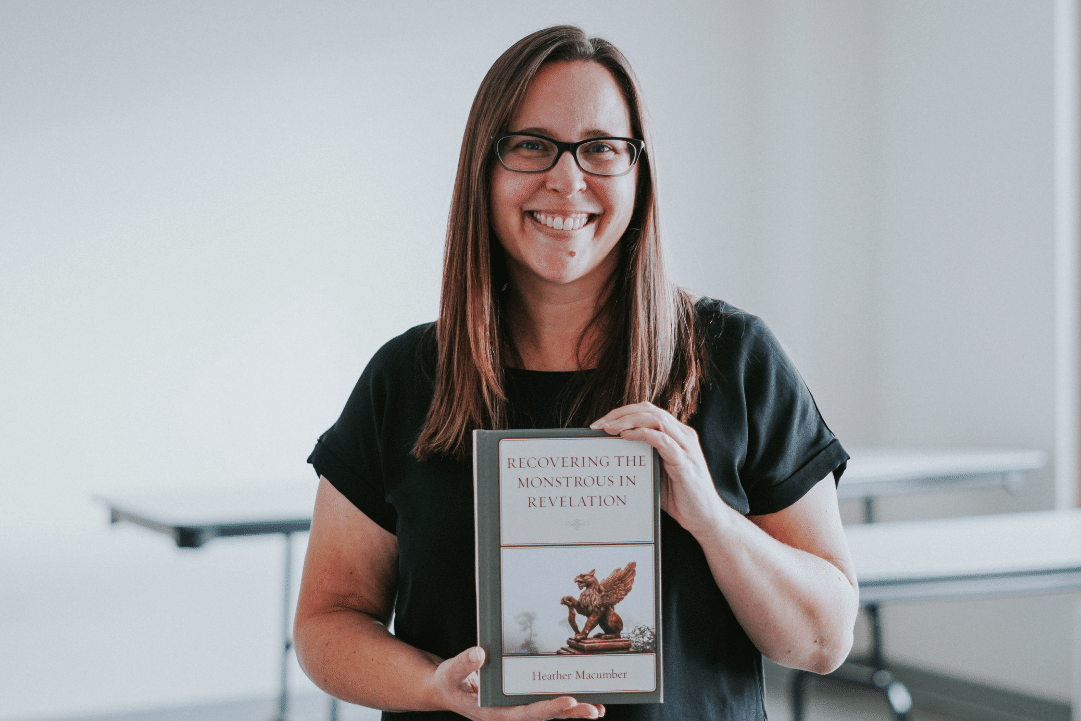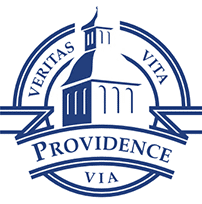OTTERBURNE, MB – Dr. Heather Macumber, Providence’s Associate Professor of Biblical Studies, released a 212-page scholarly book this fall (2021) entitled Recovering the Monstrous in Revelation. It was published by Lexington Books/Fortress Academic. The book is described as offering “an exciting new way of thinking about Revelation and its multiple monsters, from the usual suspects to those less frequently labeled as monstrous. It’s an excellent introduction to Revelation and its interpretive issues” (Lynn R. Huber, Elon University).
Like many of us, Macumber grew up with fairy tales and stories from mythology. She did her PhD thesis on Angelic Intermediaries: The Development of a Revelatory Tradition. Her inspiration for the book stemmed in part from her reading of Mary Shelley’s Frankenstein and John Milton’s Paradise Lost that both problematize the nature of the monstrous and the divine. So, you could say that she’s always had an interest in monsters and in the cosmic creatures of the Bible.
In this interview with Macumber, we discuss her book and some of the takeaways readers can glean from its pages.
Providence: Can you please explain your vision for the book and why it may differ from what people may expect?
Heather Macumber: The book developed organically from my teaching and close study of biblical texts. I continually find myself focusing on the areas of scripture that are less popular or that cause discomfort. I have long been interested in the metaphors and language that we use to understand the Divine. In my scholarship, I tend to be suspicious of categories and boxes especially when they attempt to contain God and divine beings. My goal was to read Revelation as a continuation of the Old Testament without apology for the challenging portraits of God and Christ in the book. When we read Revelation closely, it becomes quickly apparent that most of the monstrous creatures are working on behalf of the divine throne room rather than the great Red Dragon. Revelation is a tale of God’s horrific army in conflict with the dragon and the beasts. All are monsters, all are other. And this reading leaves us with an uncanny feeling – one that I argue is intentional on John’s part but that is either ignored or diminished by a selective reading of Revelation.
Providence: Who did you write the book for? What kind of reader did you have in mind as you were writing this book?
Heather Macumber: To be honest, I didn’t necessarily have a reader in mind. I wrote the book as an exploration of my own questions regarding divine activity in Revelation. It arose directly out of my teaching and the questions that students and I were raising after closely reading the biblical texts. This book would work well in an undergraduate classroom setting studying either Revelation or monster studies. A chief focus of the book is using various forms of theory (monster theory, postcolonialism, feminism) to understand not only the monstrous representations in the text but how John used them in his community both as symbols of hope and judgement.
Providence: Can you expound on the key theme or message in the book?
Heather Macumber: This book reads Revelation through the lens of the monster. It approaches all cosmic beings as other and monstrous regardless of the traditional categories of good and evil typically assigned to them. Two features of monsters, hybridity and liminality, guide the examination of all divine creatures whether they are found in heaven or the abyss. Uncovering an ancient understanding of the monstrous or fantastic body of cosmic entities is an important addition to previous studies of John’s Apocalypse. Significant attention is paid the monstrous body and how it causes both unease and wonder. Moreover, a central component of ancient apocalypses is the notion that the cosmic world reflects the concerns of the earthly communities, and one finds a similar concern in John’s visions. Thus, in addition to monster theory, the lenses of postcolonialism and feminism are employed to examine John’s relationship with empire and the assemblies of Asia Minor. Intertwined with descriptions of cosmic monsters, this book also interrogates the role of John as a maker of horror stories, who casts his opponents as the other and monstrous. Despite the tendency to view John and the heavenly creatures as the heroes of this apocalyptic tale, the aim of this study is to recover their own liminal and hybrid characteristics that mark them as monstrous.
Providence: What was one of the most surprising things you learned in your research when creating your book?
Heather Macumber: I was really surprised at how much the authors of Revelation commentaries struggled with God’s association with violence in Revelation. At almost every turn, they made excuses for how and why the disasters and plagues are attributed to God and not the great Red Dragon or the beasts. As an Old Testament scholar, the image of God as a Divine Warrior is a familiar one and I saw no need to excuse or explain away this phenomenon. I remain deeply uncomfortable at the graphic nature of violence in Revelation, but it seems clear to me that John of Patmos found it a reassuring sign of hope. Moreover, the ways that Christians have misused the violence of the Revelation against others throughout history is an indication of how little this book is understood.
Providence: Your book challenges some of the traditional ways people have read and interpreted Revelation as it suggests that all cosmic creatures are monstrous, whether they originate in heaven or hell. Do you have any interesting points about monsters in the Bible that would help people best appreciate your point of view?
Heather Macumber: One needs to start first with the understanding that monsters are not necessarily evil. Ancient monsters were considered as signs and warning from the gods. They are the ‘other’ that can horrify or overwhelm with their awe-fulness. Monsters are frequently identified as hybrid (combining disparate parts) or liminal (transgression of boundaries) and I use these descriptors to identify monsters in the biblical texts. Often people look for the monstrous in the traditional villains of Revelation like the Dragon and the beasts. However, by using hybridity and liminality as indicators of monsters, it becomes quickly apparent that figures like “the one seated on the throne” and the various permutations of Christ also participate in the monstrous. My work is not about identifying who is “good” and “evil” but rather to examine divine beings as monsters who break boundaries in their bodies and activities. Besides looking at the figures of God and Christ, significant attention is paid to other monstrous creatures like the cherubim, the four riders, the locusts, and the angelic cavalry. I argue that these beings are in service to the divine throne room and that labels of evil and demonic are inappropriate. I also examine the monstrous aspects of the great Red Dragon and the two beasts who are the clear opponents of God and divine army.
This is not a foreign perspective for biblical studies but one that is found throughout the Old Testament. The uncanniness of divine beings is present in divine council scenes (Isaiah 6; Ezekiel 1-3, 10) especially where the seraphim and cherubim are present in their composite forms. Ezekiel’s vision of the heavenly court includes these guardians of the throne of God who have four-sided faces (human, lion, ox, eagle), multiple wings and calf feet (Ezekiel 1:4-14). Although popular culture sanitizes angelic beings, they are terrifying entities in both the Old Testament and New Testament as noted from repeated instances of human terror (Daniel 7:15; Luke 2:9-10; Revelation 1:17). Additionally, the violent acts of judgement perpetrated by the locusts and four riders of the Apocalypse are reminiscent of God’s divine army in scripture (Exodus 12:23; Ezekiel 9). Though one might be uncomfortable labelling heavenly divine beings as monstrous, the biblical text does not share in this hesitancy.
Providence: Can you share your personal fascination with monsters, or more specifically your interest in ‘Monster Theory’?
Heather Macumber: J.R.R. Tolkien famously said that monsters are essential in his essay on Beowulf. He was challenging tendencies to push monsters to the margins of the text and advocating for centralizing them in the narrative. Monsters are found in every culture and all over the world. They make manifest in bodily form a culture’s fears, anxieties, and prejudices. Today we remember them as the evil villains that must be conquered by the hero/heroine but that is only one side of the story. Monsters can be evil but that is not their main qualifier; instead, in the ancient world they were dangerous, large, uncanny, and other. They inspired awe and fear. Reading scripture through this lens of monster theory opens up the text especially when considering the issue of holiness. It deepens our understanding of the complexity and the mystery of God’s being and reminds the reader of their own form of creaturehood in the presence of an overwhelming entity. It helps me to read some of the more difficult and challenging portions of scripture like Job’s night terrors where he begs God to look away from him (Job 7:11-21). I tend to gravitate to these texts that are overlooked in the modern church as they reveal a more challenging portrait of God, one I would argue is monstrous. Again, though the term monstrous may be shocking – when understood in its ancient context – it can be a positive way to approach the terrifying aspects of God’s presence (Hebrew 10:31).
Providence: Will you use your book in one of your courses at Providence?
Heather Macumber: The book grew out of teaching two courses at Providence – Monsters in the Bible and The Book of Revelation. I wouldn’t assign the book, but I will likely have students read one of the chapters.
Providence: Where can people buy your book?
Heather Macumber: The book, Recovering the Monstrous in Revelation, is available in hard cover and eBook editions at major retailers such as Amazon, Indigo and directly from the Publishing Company.
Providence: What is your next project?
Heather Macumber: I have no major book plans at the moment, but I have several articles in process featuring Monster Theory. They range from the Woman Clothed with the Sun (Revelation 12) to the Great Red Dragon (Revelation 12) to depictions of God in Ezekiel 32.
_____________________________________________________________________________________
Watch for an upcoming book review in Providence Theological Seminary’s journal Didaskalia.
Macumber has also been featured on the popular podcast called Bible for Normal People hosted by Pete Enns and on the vodcast TheoFantastique hosted by John Morehead. If you’d like to tune in to these episodes, please click on the links provided below:
https://peteenns.com/episode-184-heather-macumber-monsters-in-the-bible/
https://www.theofantastique.com/2021/10/21/heather-macumber-on-the-monstrous-in-revelation/


